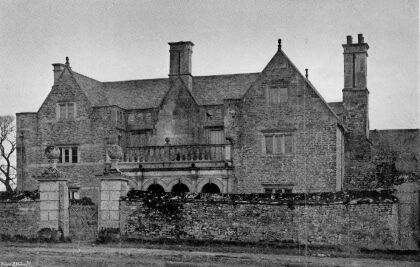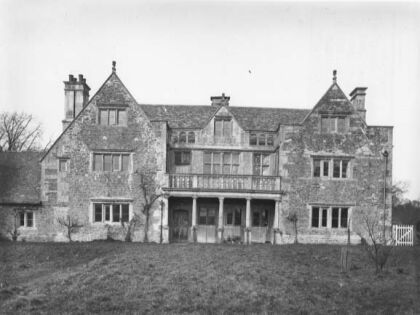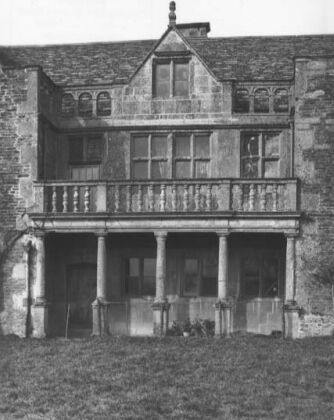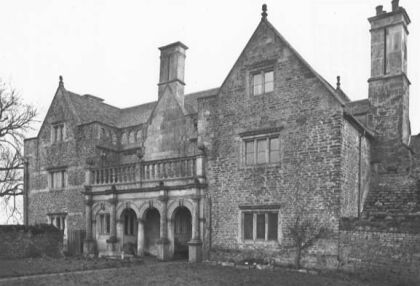Country Life - December 24th, 1910
Hambleton Hall, Hambleton, Rutland
A Lesser Country House Of The XVIIth Century
THE story of the home-life of men whose names are writ large in English history is usually fuller than the annals of the smaller manor houses. This is natural enough, for the latter were often occupied by prosperous yeomen rather than by folk entitled to be called esquire. The records of these humbler lives are to be found chiefly in the bare facts that lawsuits, wills and parish registers reveal. Occasionally, however, one comes on a batch of intimate and personal papers which throw a light on the normal current of middle-class country life in bygone days. The great diarists and letter-writers were mostly London men. Evelyn it is true, was a country gentleman, but he was also a courtier and a friend of the great. Pepys was a Cockney by adoption and only a countryman by grace. He gives us some idea of middle-class life in the notes on his visits to his people at Brampton, but it is coloured by his personal predilection for town ways and interests.

There is in consequence a special value attaching to the correspondence of Abel Barker, who was born at the Manor House at Hambleton and only left it to build himself a bigger home at Lyndon. In 1665 Barker was made a baronet, but to the methodical habits of his younger days we owe a delightful, picture of his earlier life as a prosperous gentleman farmer. From 1642 he made a practice of entering in a manuscript book copies of the most important letters he wrote, and also, fortunately, a few written by his wives. Some letters by earlier hands in the same collection take generations to the point when the Barkers were emerging into the ranks of county gentlemen.

Abel's grandfather was a Baldwin Barker, described as yeoman, who died in 1603. Baldwin's son, also an Abel, lived at Hambleton and a warrant of 1633 describes him as gentleman. The second Abel, later Sir Abel Barker, had by 1646 a position assured enough for him to be created High Sheriff of Rutland. His excursions into matrimony make an interesting story. Early in 1645 his mother, Elizabeth Barker, writes to Sir Thomas Burton, Knight and Baronet, asking that Abel may "with your consent and approbation prosecute that affection which he bears to your daughter Mrs. Anne Burton." In February Sir Thomas indicates his approval, but refers young Abel's suit to his daughter's wishes. By April Mrs. Barker was- writing again, this time about money, and suggests that Sir Thomas should give one thousand five hundred pounds "in portion"; but while she asks what he requires in return by way of jointure, it does not appear from later letters how this was settled. Abel seems to have been a writer of very moderate love-letters, if one he penned from Hambleton to his sweetheart in London just before his marriage in 1646 is fairly representative " Mrs. Anne, though the distance of place denies us our accustomed communication, yet the intercourse of letters may, if you he so pleased, supply that defect; wherein that you may not judge me oblivious of our forepassed amity, I have presumed to breake the ice, in confidence that you will not disdaine to wade after, . . " Nothing very passionate about that; but in those days it needed the genius for letter-writing of a Dorothy Osborne to set aside the usual formality of phrase. This frigidity is especially marked in the letters from Mrs. Abel Barker to her mother, and reveals the solemn way in which daughters approached their parents. "These presents," she writes in 1647, "with my humble duty. Madame, I had wayted upon you before this to have given you thanks for your many favors to me, had not Mr. Barker's extraordinary occasions and my owne sicknesse prevented me." She subscribes herself your dutifull and obedient daughter till death." The same day she is writing with more enthusiasm to "Mr. Augustine Crofts at the Nagshead in the Old Bailey near the pump there." She is in need of fripperies, and "desire you to buy me twelve elnes of a deepe watchet sarcenett for a bed, and a sleight fringe for it . . . five dozen of small silke buttons . . . an ounce of parmacity." A year later Abel's sister Mary is ordering largely from John Swinfield in Drury Lane, to the value of ten pounds and more, "a goune of black tabba, you need not make it as wide as you made my tafaty gowne by a neale (ell). You may lay upon it such lace and in such manner as is the newest fashion." She further asks for "as much tabba either grasse greene or wlllowe greene as will make me a petticote and stomacher, and make it up with as much gold and silver bone lace of about 2s. 6d ye yard as will go once about, and twice up before." Then follows a string of needs-a love hood, a riding coate and hood of scarlet serge, neatly trimmed, bandstrings, laces and ribbons.

Abel Barker seems to have been kept busy refusing offers for the hand of this sister. To his "loving friend and most faithfull and obsequious kinsman, Thomas Collin" he has to write his regrets that she "will not allowe the matter" or admit of Mr. Collin's " dedication." Whether the gentleman was soothed by the explanation that "a reason is not always found in love," and what that dim phrase may mean, does not appear. This was in 1642, and five years later Abel has to tell Sir Richard Wingfield, who was negotiating for the lady on behalf of a friend, that she is " altogether unwilling to entertain that motion." A month later Mr. Sherman of Leicester is told that "she hath disposed her thoughts some other way."
In January, 1647, Abel was mourning his wife, who died in giving birth to her only son, the second baronet. The preaching of the funeral sermon was a great function to which the countryside came, and a dinner followed. A letter of 1648 to his loving sister, Mrs. Elizabeth Goodman, has a curiously modern look, in view of recent controversies and legislation. She was intending to marry her deceased husband's brother, and Abel sets forth the sin and social obloquy attending uncanonical marriages. He implores her not "to impinge herself upon such a rocke, which besides other discommodityes will at once make shipracke of her conscience by the lawe of God and her estate and posterity by the law of man."
It may be suspected that Abel was most worried about the impending shipwreck of her estate. He remained a widower some years, but by 1655 he got a rebuff from Rebekah Partesoyle, who writes her "much respected friend ". that she cannot thinke of comitting my-selfe and estayt into the hands of any man upon 'the tennis you desier."

It looks as though Abel had been rather grasping in his proposed finance of the marriage; but the refusal cannot have come, as a surprise, for six days be/ore he got this letter he had written to Geffrey Palmer, afterwards Attorney-General to Charles II., that he had fixed his affections on Palmer's niece, Mary Noell. This went more smoothly; Noell pere seemed desperately anxious for Barker to call and fetch away the money of his daughter's portion, before even the needful documents were all signed, and the civil marriage took place before a justice, as the Commonwealth Act of 1653 required. This alliance seems to have been a very happy one. A year or two later the wife is writing to Abel in London: "Dear heart, I heare you goot safe and well to Lond, and by this time are ready to retorne to her who mournes for youre deare company. . . . Your faithfull loveing wife, Mary Barker." It happens sometimes that the sting of a wife's letter is in its tail, so the postscript must not be omitted. " Remember to by me som sherry of amber; Prea you by me a lased pinner and quioufe of the new fashion for myselfe and I would have a satten mantell for my child to crisen it in."
A few years later there is a patch of very doleful letter-writing from Hambleton. Mrs. Barker is at home looking after her babes, who are down with whooping-cough (or chincoufe, as she calls it). Small-pox is raging in the village, next door even, and folks dying all round. A later epistle reveals the children still " all sadly trobeled with the chincoufe," and the mother is frightened so much at their fits of coughing that "I am not myself." Abel is ordered to buy lozenges for them, stockings, shoes and what not. "Bell is as ragedy as a beger boy. I prae you let him have a sute." The future Lady Barker was a poor hand at spelling, even in those casual days. The unremitting attention to business and the skill he showed in farming, the steady growth in the acreage he owned and rented, were all this time increasing Abel Barker's importance. The bulk of his correspondence was about land and taxes, money and stock, and there remain also his private accounts from i665 to 1677, written in his own small and accurate hand. His baronetcy came to him, in 1665, the crown of long devotion to public affairs. He was a King's man at heart during the Civil War, but stood on the fringe of things as far as he could, serving his country in local matters rather than in those loftier spheres which meant danger to a rising business man. Among his papers is a letter from the Privy Council to the High Sheriff of Rutland in 1638, which deals with the raising of ship-money. It makes a provision, so prophetic of the present distinction between earned and unearned incomes, that it seems worthy to be transcribed here. The letter directs that " noe persons be assessed to the same unlesse they bee knowne to have estates in money or goods, or other means to live, over and above what they get by their daily labor." The autographs of Archbishop Laud and fifteen others appear on this direction to meet the cost of the Navy by a tax on unearned incomes. The Barker correspondence throws interesting light on the value of money in the seventeenth century. When Abel attended the Oakham Assizes in April, 1647, as High Sheriff, his hospitality to the judges at the Bell Inn and his presents to them cost him fifty pounds. This is a very large sum in the money of those days, and suggests that the sheriff was lavish in the discharge of his hospitable duties. Though in his later years his farming interests increased, he seems to have found time for many social diversions, as his account-book testifies. Despite that, Lady Barker had no more than fifty pounds per annum to spend on dressing herself and her three daughters, and she got only two hundred a year as her housekeeping allowance. It does not appear whether she had to repay her husband out of these sums for the clothes he bought in London in response to her impasioned postscripts.

It was only shortly before his death in 1679 that Sir Abel moved from the house at Hambleton, the subject of the accompanying pictures, to the big house which he built on his estate at Lyndon. His son, the second baronet, moved in lofty circles, for we find him in 1706 belonging to a social club, "The Honourable Order of Little Bedlam." Each member took the title of an animal. The Earl of Exeter, Great Master of the club, was Lion; the Duke of Devonshire, Leopard; and so on. They were in part an artistic set, for Sir Godfrey Kneller was Unicorn and Signor Verrio, Porcupine. Barker carried on his father's traditions by bearing the name of Ram, and one George Leafield rejoiced in the honour of representing the "Guiney Pig."
The Bankers died out in the last century, and Lyndon and Hambleton have passed to Mr. Conant. He has taken great care of Hambleton Hall by doing such repairs as are necessary but has abstained from remodelling the house within or from doing anything to take away its original characteristics as manor house of -the early seventeenth century. The gardens lie waste, but the building itself remains much as it was when Abel Baker took his brides there, save that the fitments we long ago removed to Lyndon Hall, and the interior therefore does not call for description. Each of the main fronts of the house has a loggia with a balcony above. On the north side this delightful feature seems to have been altered many years ago form a little porch at one end and to extend a room at the other. The space entered by the two middle arches has become therefore rather meaningless. The stone mullioned windows are spoilt not only by the absence of the leaded lights which are proper to them, but by the insertion of clumsy wood sashes. Though the walling is of simple rubble with dressed quoins, there is no attempt at the grand manner, one notes the charming; design of the balusters, the open arcaded parapet and the massive ashlar chimneys. Altogether, Hambleton Hall is a good example of that enchanting period of our architecture when mediaeval building tradition was perfectly married to classical taste, and their offspring maintained its English nationality unimpaired.